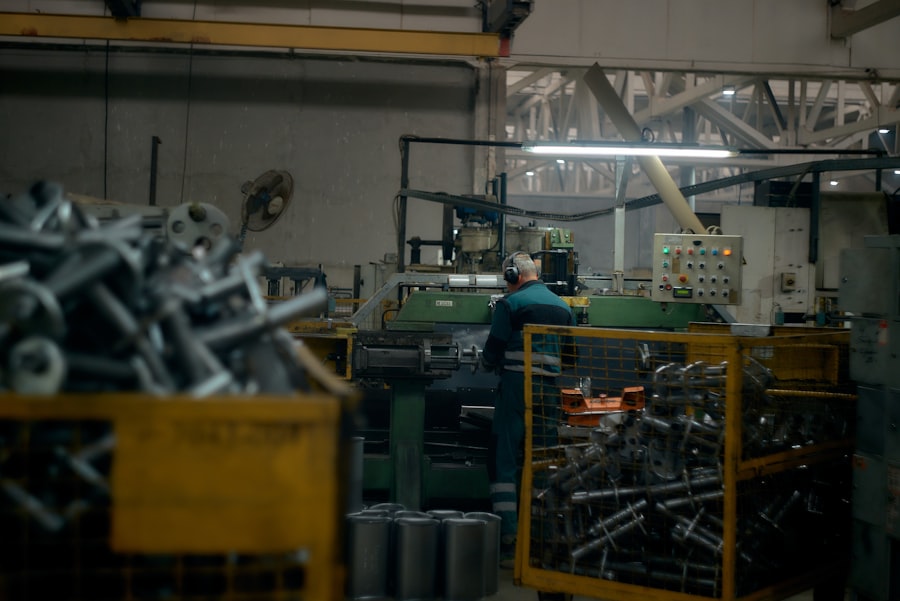Automation Ratchet represents a significant advancement in the realm of automation technology, designed to enhance efficiency and productivity across various sectors. This innovative tool allows businesses to streamline processes, reduce human error, and optimize resource allocation. By automating repetitive tasks, organizations can focus on strategic initiatives that drive growth and innovation.
The concept of the Automation Ratchet is not merely about replacing human labor; it is about augmenting human capabilities and enabling workers to engage in more complex and creative tasks. As industries continue to evolve in response to technological advancements, the importance of tools like the Automation Ratchet becomes increasingly evident. Organizations that adopt such technologies are better positioned to adapt to market changes, improve operational efficiency, and maintain a competitive edge.
The Automation Ratchet serves as a catalyst for transformation, pushing businesses toward a future where automation and human intelligence coexist harmoniously.
Key Takeaways
- Automation Ratchet is a cutting-edge tool that streamlines and automates repetitive tasks in various industries.
- The history of Automation Ratchet dates back to the early 2000s, with continuous advancements and improvements over the years.
- Automation Ratchet works by utilizing pre-defined rules and algorithms to automate tasks, reducing human intervention and increasing efficiency.
- Using Automation Ratchet offers benefits such as increased productivity, cost savings, and improved accuracy in task execution.
- There are different types of Automation Ratchet available, each tailored to specific industries and tasks.
The History of Automation Ratchet
The origins of automation can be traced back to the Industrial Revolution, when mechanization began to replace manual labor in various industries. However, the specific concept of the Automation Ratchet emerged much later, as technology advanced and the need for more sophisticated automation solutions became apparent. In the late 20th century, with the advent of computers and software development, businesses started to explore ways to automate not just physical tasks but also cognitive processes.
The term “ratchet” in this context refers to a mechanism that allows for incremental progress without regression. This principle was applied to automation technologies, leading to the development of systems that could learn from previous actions and improve over time. As industries recognized the potential of these systems, investment in automation technologies surged, paving the way for the modern Automation Ratchet.
Today, this tool is integral to many organizations, reflecting a historical trajectory that highlights the ongoing quest for efficiency and innovation.
How Automation Ratchet Works

The functionality of the Automation Ratchet is rooted in its ability to integrate various technologies, including artificial intelligence (AI), machine learning, and data analytics. At its core, the Automation Ratchet operates by automating repetitive tasks while simultaneously learning from user interactions and outcomes. This learning process enables the system to refine its operations continuously, ensuring that it becomes more efficient over time.
For instance, when a business implements an Automation Ratchet system, it begins by identifying specific tasks that can be automated. These tasks are then programmed into the system, which uses algorithms to execute them with precision. As the system processes data and receives feedback, it adjusts its approach based on performance metrics.
This iterative process not only enhances accuracy but also allows organizations to scale their operations without a corresponding increase in labor costs.
Benefits of Using Automation Ratchet
| Benefits of Using Automation Ratchet |
|---|
| 1. Increased efficiency and productivity |
| 2. Reduction in human errors |
| 3. Cost savings through reduced labor expenses |
| 4. Improved accuracy and consistency |
| 5. Faster turnaround times |
| 6. Enhanced scalability and flexibility |
The advantages of employing an Automation Ratchet are manifold. One of the most significant benefits is increased efficiency. By automating routine tasks, businesses can significantly reduce the time required for completion, allowing employees to focus on higher-value activities.
This shift not only boosts productivity but also enhances job satisfaction, as workers are freed from monotonous tasks. Moreover, the Automation Ratchet contributes to improved accuracy and consistency in operations. Human error is an inevitable factor in manual processes; however, automated systems can execute tasks with a level of precision that minimizes mistakes.
This reliability is particularly crucial in industries where compliance and quality control are paramount. Additionally, organizations can leverage data analytics capabilities within the Automation Ratchet to gain insights into their operations, enabling informed decision-making and strategic planning.
Different Types of Automation Ratchet
Automation Ratchets come in various forms, each tailored to meet specific organizational needs. One common type is robotic process automation (RPA), which focuses on automating rule-based tasks across different applications. RPA is particularly effective in finance and accounting sectors, where it can handle data entry, invoice processing, and report generation with ease.
Another type is intelligent automation, which combines RPA with artificial intelligence capabilities. This advanced form of automation allows systems to handle more complex tasks that require cognitive functions such as understanding natural language or making decisions based on data analysis. Intelligent automation is increasingly being adopted in customer service environments, where chatbots and virtual assistants enhance user experience by providing timely responses and support.
Industries That Use Automation Ratchet
The implementation of Automation Ratchet technology spans a wide array of industries. In manufacturing, for example, companies utilize automation systems to streamline production lines, manage inventory levels, and ensure quality control. By integrating these systems into their operations, manufacturers can achieve higher output rates while maintaining product quality.
In the healthcare sector, Automation Ratchets play a crucial role in managing patient records, scheduling appointments, and processing insurance claims. These automated systems not only improve operational efficiency but also enhance patient care by allowing healthcare professionals to devote more time to direct patient interactions rather than administrative tasks. Similarly, in retail, businesses leverage automation tools for inventory management and customer relationship management (CRM), ensuring that they meet consumer demands effectively.
Challenges and Limitations of Automation Ratchet
Despite its numerous benefits, the implementation of Automation Ratchet technology is not without challenges. One significant concern is the potential for job displacement as automation takes over tasks traditionally performed by humans. While automation can lead to increased efficiency and productivity, it also raises questions about workforce sustainability and the need for reskilling employees.
Additionally, organizations may face technical challenges during implementation. Integrating new automation systems with existing infrastructure can be complex and may require significant investment in training and support. Furthermore, there is always a risk associated with reliance on automated systems; technical failures or cybersecurity threats can disrupt operations and lead to costly downtime.
Future Trends in Automation Ratchet
Looking ahead, several trends are likely to shape the future of Automation Ratchet technology. One prominent trend is the increasing integration of artificial intelligence into automation systems. As AI continues to evolve, it will enable more sophisticated decision-making capabilities within automated processes, allowing organizations to respond dynamically to changing conditions.
Another trend is the growing emphasis on collaborative automation, where humans and machines work together seamlessly. This approach recognizes that while automation can enhance efficiency, human oversight remains essential for complex decision-making processes. As businesses adopt collaborative models, they will likely see improved outcomes as employees leverage automated tools to augment their skills rather than replace them.
Comparing Automation Ratchet with Other Automation Tools
When comparing Automation Ratchet with other automation tools, it becomes clear that each has its unique strengths and applications. For instance, traditional automation tools often focus on specific tasks or processes without incorporating learning capabilities. In contrast, the Automation Ratchet’s iterative learning process allows it to adapt over time and improve performance based on historical data.
Moreover, while some automation tools may require extensive programming knowledge or technical expertise for implementation, many Automation Ratchet systems are designed with user-friendly interfaces that facilitate easier adoption across various organizational levels. This accessibility makes it possible for non-technical staff to engage with automation technologies effectively.
Tips for Implementing Automation Ratchet in Your Business
For organizations considering the implementation of an Automation Ratchet system, several best practices can guide a successful transition. First and foremost, it is essential to conduct a thorough assessment of existing processes to identify areas where automation can deliver the most value. Engaging employees in this assessment can provide valuable insights into pain points and opportunities for improvement.
Once potential areas for automation have been identified, organizations should prioritize pilot projects that allow them to test the effectiveness of the Automation Ratchet on a smaller scale before full-scale implementation. This approach enables businesses to refine their strategies based on real-world feedback and make necessary adjustments before committing significant resources.
The Impact of Automation Ratchet on the Future of Work
In conclusion, the Automation Ratchet stands as a transformative force in the landscape of modern work environments. By automating repetitive tasks and enhancing operational efficiency, this technology empowers organizations to focus on innovation and strategic growth. While challenges such as job displacement and technical integration remain pertinent concerns, the potential benefits far outweigh these obstacles when approached thoughtfully.
As industries continue to embrace automation technologies like the Automation Ratchet, they will redefine traditional work paradigms and create new opportunities for collaboration between humans and machines. The future of work will undoubtedly be shaped by these advancements, leading to a more dynamic and efficient workforce capable of navigating an ever-evolving business landscape.
In the realm of technological advancements, the concept of the automation ratchet is gaining significant attention. This phenomenon describes how once a task is automated, it rarely returns to manual processes, leading to a continuous cycle of increased efficiency and reduced human intervention. For those interested in exploring the broader implications of automation on economic growth and personal wealth, an insightful article can be found on the How Wealth Grows website. This piece delves into the intersection of technology and financial prosperity, offering a comprehensive analysis of how automation is reshaping industries and individual financial strategies.
